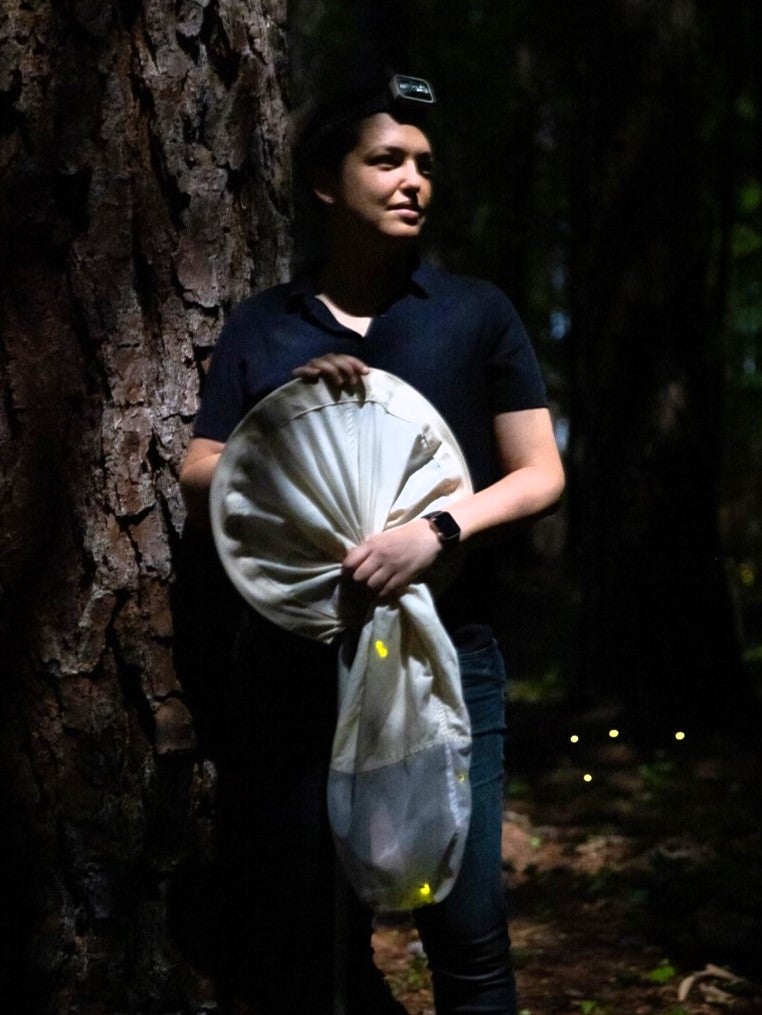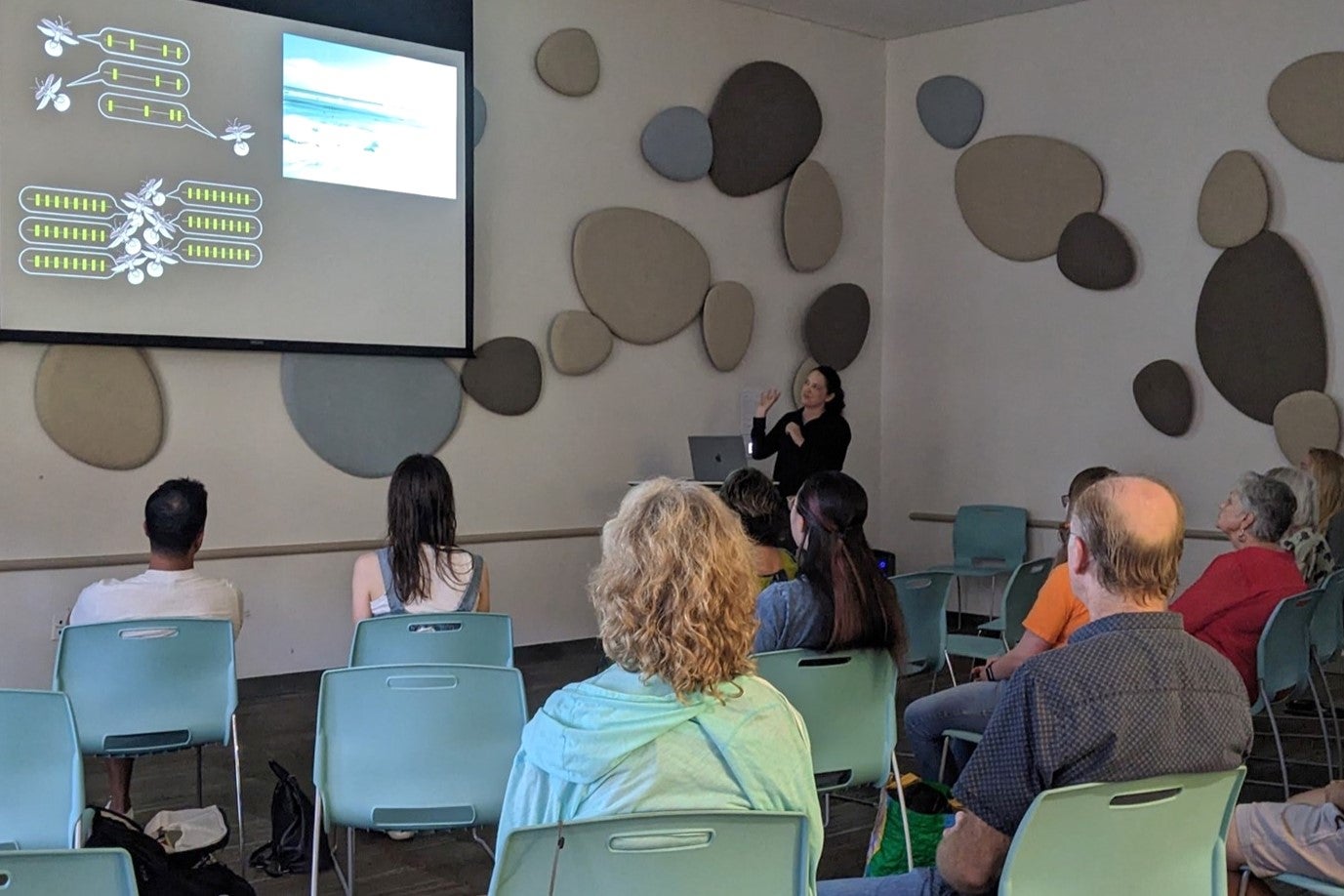Five questions for Orit Peleg
CU Boulder’s Orit Peleg, Ph.D., always has been attracted to the intersection of computing and nature.
One particular element of nature, the firefly, is illuminating research and outreach that recently earned Peleg funding via the Timmerhaus Ambassadors Fund, which supports endeavors promoting the public understanding of higher education’s value in Colorado and beyond.
“My fascination stems from observing how organisms, like fireflies, navigate complex group communications — mirroring challenges faced by computational systems,” said Peleg, an associate professor in the Department of Computer Science, College of Engineering and Applied Science, and based at the BioFrontiers Institute. “In my lab, we explore visual communication networks through fireflies’ flashing, aiming to understand their evolved distributed algorithms.”
Surprisingly, she says, such natural systems often surpass human-made telecommunication methods in navigating uncertain environments.
“In essence, my goal is to extract the inherent ‘codes’ nature has developed over eons, potentially inspiring innovations in our artificial systems,” she said.
Peleg’s deep affinity for the natural world extends into her free time.
“I often find myself absorbed in nature documentaries and popular science books,” she said. “Often, these leisurely pursuits lead me to discover unique animal behaviors that inspire new research in the lab. Beyond that, there’s a profound joy I find in immersing myself directly in nature – be it hiking or camping. These moments in the outdoors, especially when shared with my family, are truly rejuvenating and offer a perfect balance to my academic activities.”

1. Many Coloradans are surprised to learn there are fireflies living in our state. How rare are they, and where can they be observed?
Indeed, it’s a common misconception that Colorado doesn't have fireflies. However, fireflies can be found across the state. Firefly sightings have been reported throughout the Front Range, as well as in western and southeastern Colorado. The best places to observe them are open spaces with wetlands – even at elevations as high as 9,000 feet – particularly around late June through July when Colorado nights start warming up.
While a handful of species have been identified here, there’s a significant gap in our scientific understanding of many of the populations. We need more research to precisely determine the firefly species in Colorado, map their specific ranges, and their typical flash patterns. This underscores the importance and urgency of our project as we aim to shed more light on these enchanting, yet somewhat puzzling, creatures.
Our project is an interdisciplinary initiative that aims to study, document and raise awareness about the fireflies native to Colorado. By employing a blend of computer science, ecology and community engagement, we aim to map the presence and behavior of these luminescent insects throughout the state. The project leans on new technology, using off-the-shelf cameras and tailored software tools to monitor the fireflies’ flash patterns and behaviors. Using the distinct flash patterns exhibited by each firefly species, we record these flashes and employ machine learning classifiers to accurately identify the species behind each recording.
Engaging the local community is a cornerstone of our research. With the help of community scientists, often referred to as citizen scientists, we gather a more comprehensive set of observations than would be possible with our core team alone. We hope our findings will not only drive conservation efforts but also introduce the magic of Colorado’s fireflies to a wider audience, many of whom might be unaware of their presence in our region.
2. Your firefly project began last summer and will continue in the summer of 2024. How will the Timmerhaus Ambassadors funding help?

In essence, the funding provided by the Timmerhaus Ambassadors funding will ensure the smooth running of our project and will also amplify our efforts in fostering awareness about Colorado’s fireflies. A portion of the funds support Owen Martin, a talented graduate student in the Computer Science Ph.D. program. Owen seamlessly blends technological expertise with ecological understanding, managing the coordination with community scientists and overseeing the data collection, analysis and database integration. Additionally, the Timmerhaus funding has supported and will further advance our efforts in holding various events and lectures aimed at sharing knowledge with the public about fireflies and their ecological significance.
3. You also have done extensive research involving honeybees. What is your focus in this work?
Honeybees offer another intriguing model of collective communication, similar to the fireflies we study.
Bees harness a mix of chemical and tactile signals to relay critical information, such as the location of their queen and food sources. One fascinating aspect is how worker bees become amplifiers of the queen’s volatile pheromone signals. These bees detect the pheromone and then transmit similar signals to the rest of the swarm, creating a dynamic communication network that aids in locating the queen over vast distances.
Our research has also examined the honeybees’ efficient “charging” system, where foraging bees regurgitate food to “recharge” their peers, a process called Trophallaxis. This remarkable system of energy distribution is highly efficient and might even offer inspiration for swarm robotics, ensuring effective energy dissemination.
From a mechanical perspective, bees’ ability to form large, stable clusters in cold temperatures, and how they dynamically adjust to environmental changes, such as wind, has been another focus of our study. Our latest techniques, like X-ray CT scanning, have unveiled internal swarm structures, improving our understanding of these remarkable creatures and their collective behaviors.
By studying both fireflies and bees, we gain a deeper understanding of nature’s intricate communication networks, potentially unlocking insights for applications in modern technology and robotics.
4. You mentioned community scientists or citizen scientists. What is citizen science, and why is it important for working scientists?
Citizen science is the involvement of the general public in scientific research, where individuals without formal training contribute to various stages of the scientific process. Its significance lies in its ability to vastly amplify data collection over diverse locations and periods, enriching the scientific database. It also fosters community engagement, bridging the gap between professionals and the public, and introduces hands-on educational experiences about the scientific process.
Recently, there has been a movement toward using the term “community science” instead of “citizen science” to be more inclusive and to emphasize the community’s collaborative nature in scientific endeavors.
For researchers, especially in the context of studying fireflies, this form of collaboration is invaluable. Fireflies are elusive creatures, existing only for a few weeks each year and flashing just a few hours nightly. Pinpointing their locations is challenging, and even if we did have this knowledge, covering all these locations simultaneously is impossible for just me and my lab members. Community science helps bridge this logistical gap.
5. How have community scientists been involved in your firefly project so far and how can others get involved in the future?
We held several events where our team, including Owen Martin and myself, shared detailed information about the firefly life cycle, flash behavior and the species likely to be found in various regions of Colorado. Owen has been active in events such as “Light Up the Night” in Fort Collins and “Fireflies in the Meadow” in Loveland. I took part in “Firefly Tailgate” in Boulder, and also delivered a public lecture titled “Fireflies’ Fantasia: Illuminating the Mysteries of Living Lights in Colorado and Beyond” at the Little Creatures Insect Exhibit at Boulder Public Library.
Furthermore, through these events, we provided interactive materials and hands-on activities for attendees of all ages, ensuring that everyone can grasp the significance of fireflies in our ecosystem and the importance of conserving them. By fostering this community involvement, we believe we are not just conducting research but also strengthening the movement toward the appreciation and protection of Colorado’s natural wonders.
For those eager to be a part of this illuminating journey, there are multiple avenues to get involved. First and foremost, individuals can sign up as community scientists using this link: https://forms.gle/jxGZbnbkatf4B3NQ7
By joining this group, selected participants will receive training on how to observe, document and report firefly sightings, making a tangible contribution to our research. Additionally, we regularly host community events where participants can learn more about fireflies and our project’s goals. These events offer excellent opportunities for hands-on learning and direct interaction with our research team. We wholeheartedly welcome everyone’s enthusiasm and interest. Together, we can shed light on the mysteries of Colorado’s fireflies and ensure their conservation for future generations.



